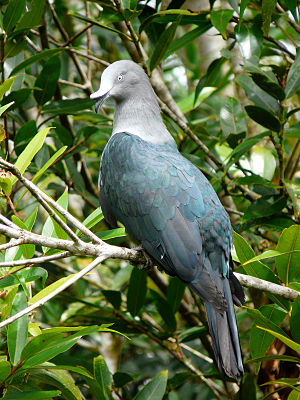Marquesas fruit pigeon
| Marquesas fruit pigeon | ||||||||||
|---|---|---|---|---|---|---|---|---|---|---|

Marquesas fruit pigeon |
||||||||||
| Systematics | ||||||||||
|
||||||||||
| Scientific name | ||||||||||
| Ducula galeata | ||||||||||
| ( Bonaparte , 1855) |
The Marquesas pigeon ( Ducula galeata ), also Marquesasfruchttaube written is a very large type of pigeon birds, to the fruit pigeons counts. It occurs exclusively on two small islands in the Marquesas , a group of islands in Eastern Polynesia.
The population of the Marquesas fruit pigeon was classified in the IUCN Red List of Threatened Species in 2016 as " Endangered (EN) " = "critically endangered".
Appearance
The Marquesans fruit pigeon reaches a body length of about 55 centimeters. It is thus slightly larger than a wood pigeon . The tail accounts for 18.1 to 23 centimeters. There is no noticeable gender dimorphism . The females are just a little smaller.
The basal half of the beak is covered by a soft, heavily swollen skin close to the base, which is pinnate from the middle in this species. In the front area this is bent upwards. Due to the fletching of the wax skin, the forehead of the Marquesas fruit pigeon appears very flat. The tail is very long in relation to the body size.
The front of the head is cream colored, the crown and the neck are gray. The mantle, the back and the wing covers are dark green with a greenish-blue tinge. The chest and stomach are gray. On the lower abdomen, the plumage has a light brownish to chestnut brownish tint. The under tail coverts are maroon. The beak is dark, the iris is cream colored. The feet and legs are dark red.
There is no other species of pigeon in the Marquesas fruit pigeon distribution area with which it could be confused.
Distribution area
The Marquesas fruit pigeon is a species of the Marquesas. The Marquesas is a group of islands in the Pacific Ocean that includes 14 islands and numerous small islets. They are divided into a northern group with the main islands of Nuku Hiva , Ua Pou and Ua Huka and a southern group with Hiva Oa , Tahuata and Fatu Hiva . The only large animals are farm animals such as horses, cattle, pigs and chickens. The animal world on land is otherwise limited to insects , snails and lizards. Numerous endemic bird species are native to the rainforests of the archipelago. In addition to the Marquesas pigeon arrive on the islands as the Marquesastaube ( Gallicolumba rubescens ), the Marquesasliest ( Todiramphus godeffroyi ), the Marquesas Monarch ( Pomarea mendozae ), the Iphis-flycatcher ( Pomarea Iphis ), the endemic to the island of Ua Huka is, and the Fatuhivamonarch ( Pomarea whitneyi ), which occurs only on Fatu Hiva .
The Marquesas fruit pigeon was only found on Nuku Hiva until 2000. With an area of around 340 km² and 2,660 inhabitants, it is the largest and most populous island in the Marquesas. In 2000, some of the pigeons were started to settle on Ua Huka. It is estimated that 200 pigeons could live on this island. In 2006 the population living there was already 46 individuals. In 2010 several nests of the Marquesas fruit pigeon were also found there.
On Nuka Niva, the Marquesas fruit pigeon can only be found in the west and northwest of the island. This limitation has existed for a long time: as early as 1921, when the Whitney South Sea Expedition visited the island, the pigeon species was only represented in these regions of the island. There the pigeon colonizes forest areas in small valleys and high plateaus at altitudes between 250 and 1300 meters. Some individuals can also be found in small groves just at sea level. In some areas of the island it is also found in the secondary forest, which is directly adjacent to banana and orange plantations.
Originally, the pigeon was widespread in the Marquesas Islands. It is still debatable whether the species was even once found in the Society Islands , Cook Islands and the Pitcairn Islands . The bone finds there could, however, also belong to another, now extinct, large fruit pigeon .
Way of life
The Marquesans fruit pigeon lives solitary or in pairs. Occasionally, however, several individuals congregate in a single, fruiting tree. They are not considered particularly shy. They eat large fruits with a diameter of up to 5 centimeters, which they find in the tree tops. They spend most of the day sitting still in the treetops.
Nests were found in May and July and September and October. Presumably they can brood all year round. The nest is built high in the treetops. The clutch consists of a single white egg.
literature
- David Gibbs, Eustace Barnes, John Cox: Pigeons and Doves - A Guide to the Pigeons and Doves of the World . Pica Press, Sussex 2001, ISBN 90-74345-26-3 .
- Gerhard Rösler: The wild pigeons of the earth - free living, keeping and breeding . M. & H. Schaper Verlag, Alfeld-Hannover 1996, ISBN 3-7944-0184-0 .
Web links
- Ducula galeata in the endangered Red List species the IUCN 2013. Posted by: BirdLife International, 2013. Retrieved on November 5 2016th
- Call of the Marquesas fruit dove on Xeno-Canto
Individual evidence
- ↑ Avibase on the Marquesas fruit pigeon , accessed on November 5, 2016.
- ↑ a b c Ducula galeata in the endangered Red List species the IUCN 2016 Posted by: BirdLife International, 2016. Retrieved on 3 October 2017th
- ↑ a b D. Gibbs, E. Barnes, J. Cox: Pigeons and Doves. 2001, p. 544.
- ↑ a b c D. Gibbs, E. Barnes, J. Cox: Pigeons and Doves. 2001, p. 543.
